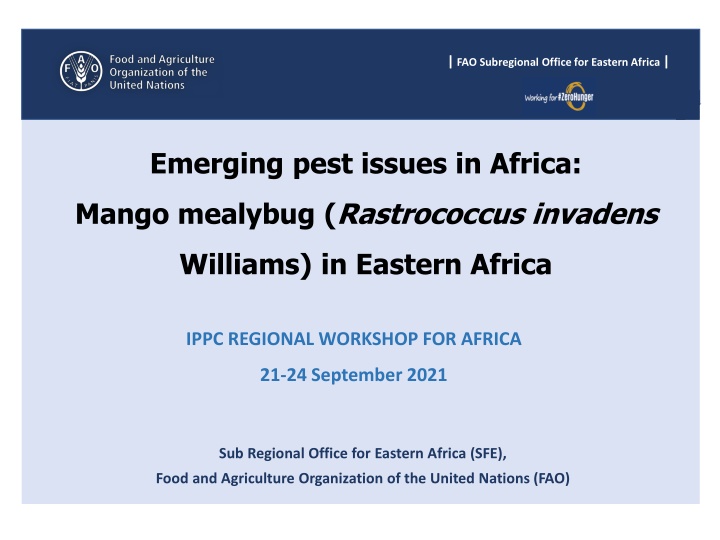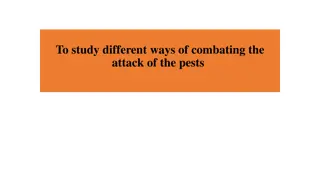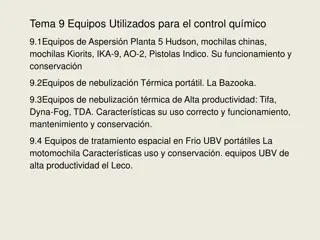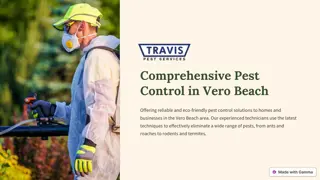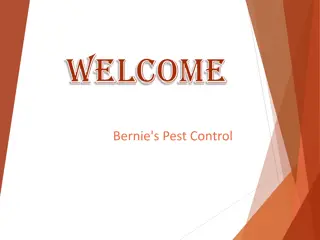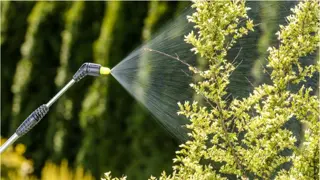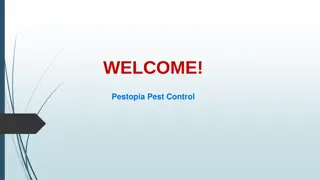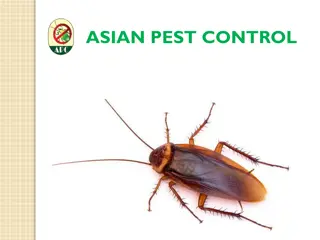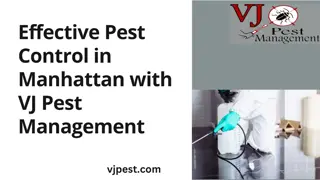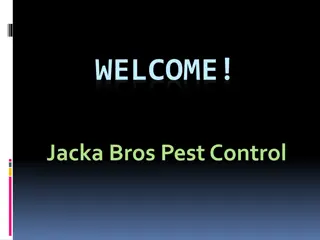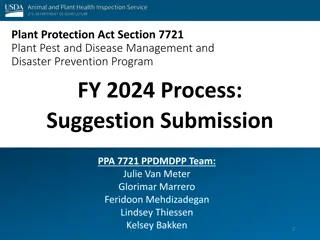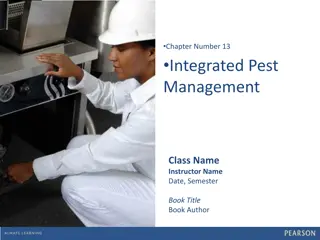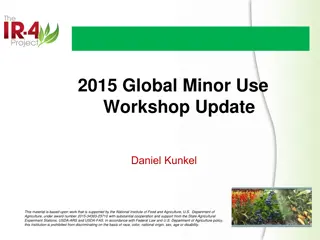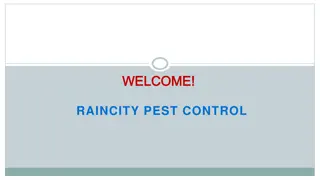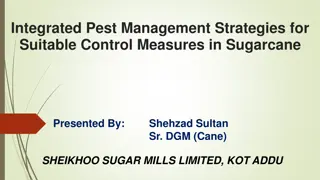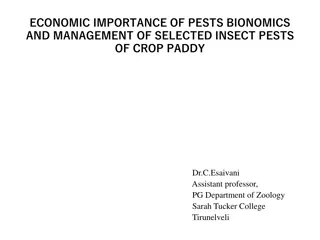Emerging Pest Issues in Eastern Africa: Mango Mealybug Impact
The Mango Mealybug, originating from South-East Asia, has become a significant threat to horticultural crops in Africa, causing notable yield losses in countries like Ghana and Côte d'Ivoire. With a host range of over 100 plant species, it particularly targets mango plants, affecting their photosynthetic ability and overall productivity. This pest releases a sugary substance that leads to the formation of sooty mold, impacting plant growth and fruit production.
Download Presentation

Please find below an Image/Link to download the presentation.
The content on the website is provided AS IS for your information and personal use only. It may not be sold, licensed, or shared on other websites without obtaining consent from the author.If you encounter any issues during the download, it is possible that the publisher has removed the file from their server.
You are allowed to download the files provided on this website for personal or commercial use, subject to the condition that they are used lawfully. All files are the property of their respective owners.
The content on the website is provided AS IS for your information and personal use only. It may not be sold, licensed, or shared on other websites without obtaining consent from the author.
E N D
Presentation Transcript
| FAO Subregional Office for Eastern Africa | Emerging pest issues in Africa: Mango mealybug (Rastrococcus invadens Williams) in Eastern Africa IPPC REGIONAL WORKSHOP FOR AFRICA 21-24 September 2021 Sub Regional Office for Eastern Africa (SFE), Food and Agriculture Organization of the United Nations (FAO)
| FAO Subregional Office for Eastern Africa | OUTLINE OUTLINE 1) Mango mealybug damage and host range 2) Impact of mango mealybug in Africa 3) Response to curb impacts of mango mealybug 4) The way forward for sustainable management of mango mealybug
| FAO Subregional Office for Eastern Africa | 1. MANGO MEALYBUG DAMAGE AND HOST RANGE
| FAO Subregional Office for Eastern Africa | The Mango Mealybug The Mango Mealybug
| FAO Subregional Office for Eastern Africa | The mango mealybug, known also by its scientific name Rastrococcus invadens Williams (Hemiptera: Pseudococcidae), is originated in South-East Asia. It has been the most important polyphagous pest of horticultural crops since 1982 in West African countries Togo, Benin, Ghana, C te d Ivoire, Nigeria and Senegal. This emergent plant pest, mango mealybug probably introduced to West Africa on infested plant material.
| FAO Subregional Office for Eastern Africa | DAMAGE AND HOST RANGE Affects the photosynthetic ability of host plants by releasing a sugary substance that coats the leaves of affected plants which serves as a substrate for sooty mould. This mould blackens the leaves, leading to reduced productivity of the plant. Heavily affected plant parts stop growing, and often no new leaves or flowers are produced.
| FAO Subregional Office for Eastern Africa | Mango mealybug has been reported causing 80% of mango yield losses in Ghana and 53% to 100% reduction of total production in C te d Ivoire. The mango mealybug is known to have a host range of over 100 plant species. However, the mango plant is the preferred host.
| FAO Subregional Office for Eastern Africa | 2. IMPACT OF MANGO MEALYBUG IN AFRICA
| FAO Subregional Office for Eastern Africa | IMPACT OF MANGO MEALYBUG IN AFRICA The mango mealybug, Rastrococcus invadens Williams spreads wild in Benin, Burkina Faso, C te d Ivoire, Ghana, Guinea, Mali, and Togo because control effort deployed by each single country is having little impact on their population. The mango mealybug appeared in 1989 at the eastern border of C te d Ivoire and became in less than four years a major constraint to fruit production nation-wide (Hala et al. (2004).
| FAO Subregional Office for Eastern Africa | In Guinea, the area of mango mealybug attacks has widened rapidly to include the four regions of mango production in the country (Traor , 2001) and Bald , 2002). The appearance of the mealy bug in the southern region of Burkina Faso for instance is an indication that the pest came from northern C te d Ivoire where it was first reported in the eastern region of that country in 1986 meaning that it probably came from Ghana where the pest was already present in the early 1980s.
| FAO Subregional Office for Eastern Africa | NEW EMERGING PLANT PESTS DETECTED IN EASTERN AFRICA Mango mealybug, Rastrococcus invadens Williams was detected in Rwanda (October 2019), and officially reported to IPPC. There is diagnostic confirmation of the presence of Mango Mealybug in Burundi but official report to the IPPC is pending. Papaya mealybug, Paracoccus marginatus was detected in Uganda in July 2021, and officially reported to IPPC. With Rwanda and Burundi, the mango mealybug is now distributed in a total of 13 African nations.
| FAO Subregional Office for Eastern Africa | MANGO MEALYBUG SURVEY RESULTS IN RWANDA Survey findings in Rwanda revealed that Mango mealybug was already established in three locations: The Urban centers (Kigali city), East and Southern regions. No infestation recorded in west and Northern Provinces. The high infestation was found in urban centers and the Eastern Province.
| FAO Subregional Office for Eastern Africa | Mango mealybug sampled and parasitoids release sites in Rwanda
| FAO Subregional Office for Eastern Africa | 3. RESPONSE TO CURB THE MANGO MEALYBUG
| FAO Subregional Office for Eastern Africa | RESPONSE TO CURB IMPACTS OF MANGO MEALYBUG The African Union had developed a biological control program for the mango mealybug Rastrococcus invadens Williams (Homoptera: Pseudococcidea) in West Africa. Rastrococcus invadens has been successfully put under control in Benin, Ghana, Togo, Gabon, Nigeria, Sierra Leone and Zaire using biological control exerted by two parasitoid wasps, Gyranusoidea tebygi Noyes and Anagyrus mangicola Noyes (Hymenoptera: Encyrtidae) released in the eighties.
| FAO Subregional Office for Eastern Africa | All releases of the parasitoid wasps resulted in successful establishments. The parasitoid proved to be an effective biological control agent against Rastrococcus invadens Williams by establishing a marked and stable reduction of the pest levels in all the infested zones where it has been released (Agricola et al. 1989; Matokot et al. 1992; Neuenschwander et al., 1994, Boavida et al. 1995).
| FAO Subregional Office for Eastern Africa | To respond to mango mealybug incidences in Rwanda, FAO SFE has developed a Technical Cooperation Programme TCP/SFE/3801 (E): Enhance the preparedness and response capacity of the countries of the Sub-Regional Office for Eastern Africa to the mango mealybug (Rastrococcus invadens Williams) (Phase 1), covering three countries (Rwanda, Burundi and Uganda)
| FAO Subregional Office for Eastern Africa | Under this TCP/SFE/3801, the following activities coducted Preparations of FAO SFE Technical Brief on Mango Mealybug Technical Note for the control of mango mealybug (Rastrococcus invadens) in urban and agricultural areas Survey Guidelines for Mango Mealybug Recommended Steps-import biocontrol agent Guide on finding of no significant impact Guide for preparing Mango Mealybug specimens for laboratory diagnosis
| FAO Subregional Office for Eastern Africa | National mango mealybug taskforces established in the three countries (Rwanda, Burundi and Uganda) Training of officers in the three countries conducted (both virtual and face to face) Survey of mango mealybug incidences across the three countries undertaken Sample collection and identification by the British Natural History Museum in London Preparation of dossier for importation and releases of two biological control agents: Gyranusoidea tebygi Noyes and Anagyrus mangicola Noyes (Hymenoptera: Encyrtidae) in Rwanda
| FAO Subregional Office for Eastern Africa | Letter of Agreement with the International Institute of Tropical Agriculture (IITA) for provision of Biological Control Support for the Management of Mango Mealybug in Eastern Africa Letter of Agreement with the Kenya Plant Health Inspectorate Service (KEPHIS) for provision of Specialized Taxonomic Training on Mealybugs and Pest Risk Analysis Training for National Plant Protection Organizations in Eastern Africa Conduct a biweekly Virtual Tripartite Meeting of TCP/SFE/3801 on Mango Mealybug in Rwanda, Burundi, and Uganda (now it is 26th)
| FAO Subregional Office for Eastern Africa | 4. THE WAY FORWARD FOR SUSTAINABLE MANAGEMENT OF MANGO MEALYBUG
| FAO Subregional Office for Eastern Africa | WAY FORWARD Invasive insects are non-observing borders pests and consequently should be fought regionally instead of trying to control them at country level In addition, no single country has the capacities to undertake a meaningful action alone Establishment of a mass rearing laboratory in Rwanda, to serve as a hub for Eastern Africa
